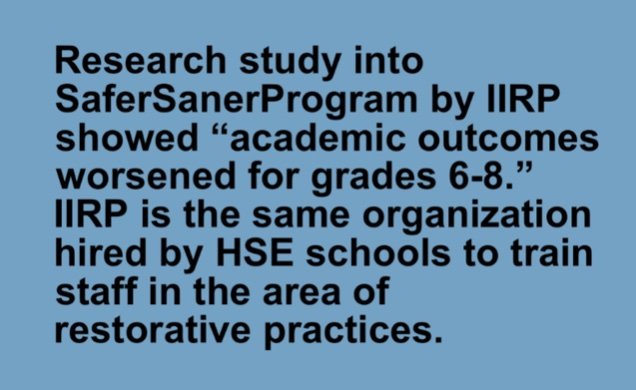Maybe We Should Sweat the Small Stuff
By Kellie Kelly
Dr. Chad Carmichael wrote an article in December of 2021 concerning the hiring of IIRP, International Institute for Restorative Practices, to train HSE staff in the implementation of a new discipline program. When I reread his article recently, one paragraph in particular caught my attention.
“In other words, IIRP sees the move to restorative practices as constituting a fundamental change, and not just as one disciplinary tool among many. Parents need to therefore be aware that, if HSE follows IIRP’s vision here, we could have some serious problems.“
Currently, HSE Schools is seeing an uptick in disruptive behaviors among students including fights. On April 26, 2023, a student from Sand Creek Intermediate brought a knife from home and caused minor injuries to another student. Is Dr. Carmichael’s warning back in 2021 that “we could have some serious problems” coming true? Is his concern that restorative practices “will be used in situations where they are insufficient to achieve the needed correction of serious misbehavior” a contributing factor to the increase in disorderly behaviors at HSE Schools?
Currently, HSE Schools is seeing an uptick in disruptive behaviors among students including fights. On April 26, 2023, a student from Sand Creek Intermediate brought a knife from home and caused minor injuries to another student. Is Dr. Carmichael’s warning back in 2021 that “we could have some serious problems” coming true? Is his concern that restorative practices “will be used in situations where they are insufficient to achieve the needed correction of serious misbehavior” a contributing factor to the increase in disorderly behaviors at HSE Schools?
To help answer these questions, let’s do some research into a different form of discipline practice which is found in paternalistic schools. What is exciting about this research is the fact that paternalistic schools have been able to both curb disruptive behaviors and narrow the achievement gap, an impressive accomplishment indeed! Do the scientific research studies on restorative practices show promising results? Read on to find out.
First starting with a bit of background, in 1982 the broken windows theory was introduced in an article by James Wilson and George Kelling titled, “Broken Windows.” To summarize the article, the authors claim that if problems are addressed promptly when they are small then there is less likelihood of the problems becoming larger. For example, if a sidewalk has litter then clean it up every day so the likelihood of litter accumulating is much less. The theory is that individuals look for “signals in the environment” to establish social norms. A sidewalk that is clean, orderly, and maintained sends a message that littering is not acceptable or allowed.
The broken windows theory has been applied to criminology, urban sociology, the real estate industry, as well as education. One of the major studies in education is by Stephen Plank from Johns Hopkins University. Plank’s study researched whether there was a correlation between the physical appearance of schools and student behavior. Plank found a statistical correlation between variables such as “fear, social order, and social control” with the physical conditions of the school environment. His research showed that improving the physical appearance and orderliness of a school or classroom can help promote a more “productive setting” and discourage disorderly behavior. Further applications in education concern when a student is being disorderly in a classroom. A disorderly student sends a message to other students that it is ok to break classroom rules and create more disorder.
David Whitman is a freelance journalist and former writer at U.S. News & World Report. His book titled, Sweating the Small Stuff, is based on research into six urban schools. These schools have similar traits and goals. They work with low-income minority students from urban settings, are “paternalistic institutions”, and have proven success records when it comes to closing the achievement gap. The following chart is from Whitman’s article in Education Next. It shows that the Amistad Academy in New Haven, CT with a 98% minority rate, 67% low income rate, and less per-pupil funding outperformed the New Haven public school district on the Connecticut Mastery Test in 2006-2007.
Whitman claims the academic gains are due to the dedicated teachers and staff, the college-prep curriculum, and the paternalistic school environment and culture. A paternalistic school environment is dedicated to “curbing disorder”. Using the broken windows theory, these schools pay “inordinate attention to making sure that shirts are tucked in, bathrooms are kept clean, students speak politely, and trash is picked up.”
Other behaviors that are monitored include teachers noting whether students are paying attention in class by checking to see if students are “tracking them with their eyes”, “nodding their heads to show they are listening”, or “slouching in their seats.” At Amistad Academy if a student “calls out in class”, “distracts other students”, or “rolls his eyes at a teacher” then he is sent to a “time out” desk or loses school privileges.
Some effective strategies used in paternalistic schools include setting high standards for all students, setting goals that all students will go to college, extending the school year as well as school days, placing an emphasis on the “importance of acquiring basic facts and skills”, hiring dedicated and effective teachers regardless of certification, and firing teachers who are not effective in the classroom. Students are tested frequently to monitor academic achievement. Accountability is maintained for both students and teachers.
However, “paternalism” is considered by many to be a negative system of beliefs restricting the freedoms of individuals. Whitman points out that the schools he visited use a “gentler form of paternalism.” Dedicated teachers and staff form real connections with their students. Students often refer to their school as a “second home.”
An interesting takeaway from this research would support the conclusion that by fixing broken windows promptly and fostering a paternalistic school climate, academic outcomes increase. Is the reverse also true? Do academic outcomes worsen when schools lower standards, no longer maintain accountability, and promote a school climate which is disorderly and sends the wrong messages?
From reading posts made by parents with children in the HSE public school district, many are concerned with the uptick in disorderly behavior, fighting, and school violence in the public schools. Parents want to know what is causing the increase and how to curb this trend. Many are questioning if the new school climate based on restorative justice/restorative practices instead of more traditional methods of discipline is contributing to the disorder in our schools.
The theory behind restorative practices involves not punishing students for bad behavior, but instead teaching them how the bad behavior “breaks the community’s circle of trust”, showing them “how to ask for forgiveness”, and asking them “to return to their community.” There are some promising results. Some schools showed improvements in lowering out-of-school suspension rates and expulsion rates. However, there are very few scientific studies which use objective criteria and scientific design with comparisons between testing and control groups.
One such study (Acosta, 2019) collected “baseline and two-year post survey data from 2,771 students at 13 middle schools.” The population consisted of 48 percent sixth graders and 52 percent seventh graders. The results of the study showed “no significant differences between intervention and control schools in student outcomes (connectedness, developmental outcomes, and bullying victimization.”
Another study (Augustine, 2018) collected data from 44 schools in the Pittsburgh Public Schools District. The schools were evenly split between treatment and control groups. The treatment schools or PERC schools (Pursuing Equitable and Restorative Communities) implemented restorative practices using the SaferSanerSchools program. This program was developed and is taught by IIRP, the same organization that provided training for HSE staff.
The two year study collected data including “outcomes at the student level (suspensions, arrests, attendance, mobility, and achievement), the teacher level, and the school level.” Key findings of the study found that “PERC schools improved in overall school climate” and “reduced the average suspension rate.” However, “academic outcomes did not improve in PERC schools, and actually worsened for grades 6-8.” Of specific note, “math test scores deteriorated for black students.” Also, “arrest rates among PERC schools did not decrease.”
The theory of restorative practices is popular among education activists because restorative practices reduce traditional school discipline rates such as suspensions and expulsions which activists believe unfairly target certain groups. Advocates claim that restorative practices can reduce bullying and fighting, lower suspension rates, increase attendance, and improve school achievement. However, the scientific studies contradict what the activists, advocates, and reformers are promoting.
What is the real purpose of our public schools? If it truly is to improve academic achievement and work to close the achievement gap for all students, then the research shows that paternalistic schools who “fix their broken windows promptly” and “sweat the small stuff” are effective. However, activist reform trends such as restorative practices are not effective in improving academic outcomes (Rand Study) and may indeed be a contributing factor to both the widening of the achievement gap as well as the increase in disorderly student behavior. I hope that the HSE administration and the HSE school board members will take a hard look at the scientific data collected for restorative practices/restorative justice programs and reconsider this discipline approach in HSE Schools.
References:
Carmichael, Chad (2021). HSE Hires “Restorative Practices” Group that Promotes Racist Ideas, The Millstone.
Wilson, J.Q., & Kelling, G. L. (1982). Broken Windows, Atlantic Monthly.
Plank, S. B., Bradshaw C.P., & Young H. (2009). An application of “broken windows” and related theories to the study of disorder, fear, and collective efficacy in schools. American Journal of Education.
Whitman, David (2008). Sweating the Small Stuff, Thomas B. Fordham Institute.
Whitman, David (2009). An Appeal to Authority, Education Next.
Goodwin, Bryan (2021). Research Matters/Does Restorative Justice Work?, ASCD.
Acosta, J. Et al (2019). Evaluation of a whole-school change intervention: Findings from a two-year cluster-randomized trial of the restorative practices intervention. Journal of Youth and Adolescences.
Augustine, Catherine H. Et al (2018). Can Restorative Practices Improve School Climate and Curb Suspensions? An Evaluation of the Impact of Restorative Practices in a Mid-Sized Urban School District, RAND Corporation.
Mas-Exposito, Laia Et al (2022). Implementation of Whole School Restorative Approaches to Promote Positive Youth Development : Review of Relevant Literature and Practice Guidelines, Education Sciences.
Barshay, Jill (2019). The promise of ‘restorative justice’ starts to falter under rigorous research, The Hechinger Report.





